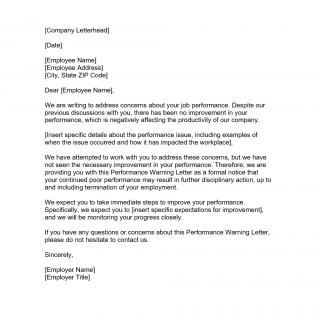Performance Warning Letter
The Performance Warning Letter is a form used by employers to address an employee's poor job performance and provide a warning that further disciplinary action may be taken if the employee does not improve their performance. The main purpose of this form is to document the employer's concerns about the employee's performance and provide a clear warning that the employee needs to improve in order to avoid further disciplinary action.
The form consists of several parts, including the date of the warning, the employee's name and job title, a description of the performance issue, and a warning that further disciplinary action may be taken if the employee does not improve their performance. The important fields to consider when completing this form include the specific performance issue that needs to be addressed, the expected improvement that the employer is looking for, and the consequences of continued poor performance.
The parties involved in this form are the employer and the employee. The employer is responsible for completing the form and providing the warning, while the employee is responsible for acknowledging the warning and taking steps to improve their performance.
When completing this form, the employer will need to provide specific details about the employee's performance issue, including examples of when the issue occurred and how it has impacted the workplace. It is also important to attach any relevant documentation, such as performance evaluations or other records that support the employer's concerns.
Poor Performance Warning Letter sample
[Date]
[Employee Name]
[Employee Address]
[City, State ZIP Code]
Dear [Employee Name],
We are writing to address concerns about your job performance. Despite our previous discussions with you, there has been no improvement in your performance, which is negatively affecting the productivity of our company.
[Insert specific details about the performance issue, including examples of when the issue occurred and how it has impacted the workplace].
We have attempted to work with you to address these concerns, but we have not seen the necessary improvement in your performance. Therefore, we are providing you with this Performance Warning Letter as a formal notice that your continued poor performance may result in further disciplinary action, up to and including termination of your employment.
We expect you to take immediate steps to improve your performance. Specifically, we expect you to [insert specific expectations for improvement], and we will be monitoring your progress closely.
If you have any questions or concerns about this Performance Warning Letter, please do not hesitate to contact us.
Sincerely,
[Employer Name]
[Employer Title]
Strengths of this form include its ability to clearly document the employer's concerns and provide a warning that further disciplinary action may be taken. Weaknesses may include the potential for the employee to become defensive or uncooperative, which could make it more difficult to address the performance issue.
Alternative forms that may be used in place of the Performance Warning Letter include verbal warnings, written warnings, and performance improvement plans. Each of these forms has its own strengths and weaknesses, and the choice of form will depend on the specific circumstances of the situation.
To fill out and submit the Performance Warning Letter, the employer should follow their company's established procedures for disciplinary actions. This may include meeting with the employee to discuss the performance issue, providing a copy of the form to the employee, and giving the employee a specific timeframe in which to improve their performance. The completed form should be stored in the employee's personnel file for future reference.
In summary, the Performance Warning Letter is a valuable tool for employers to address poor job performance and provide a warning that further disciplinary action may be taken. It is important to complete the form accurately and thoroughly, attach any relevant documentation, and follow the company's established procedures for disciplinary actions. Alternative forms may also be considered depending on the specific circumstances of the situation.

